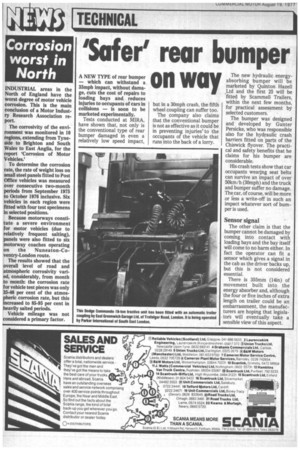'Safer' rear bumper on way
Page 28

If you've noticed an error in this article please click here to report it so we can fix it.
A NEW TYPE of rear bumper — which can withstand a 35mph impact, without damage, cuts the cost of repairs to loading bays and reduces injuries to occupants of cars in collisions — is soon to be marketed experimentally.
Tests conducted at MIRA, have shown that, not only is the conventional type of rear bumper damaged in even a relatively low speed impact, but in a 30mph crash, the fifth wheel coupling can suffer too.
The company also claims that the conventional bumper is not as effective as it could be in preventing injuries to the occupants of the vehicle that runs into the back of a lorry. The new hydraulic energyabsorbing bumper will be marketed by Quinton Hazell ,Ltd and the first 25 will be fitted by Scammell Trailers, within the next few months, for practical assessment by selected customers. • The bumper was designed and developed by Gunter Persicke, who was responsible also for the hydraulic crash barriers fitted on parts of the Chiswick flyover. The practical and safety benefits that he claims for his bumper are considerable.
His crash tests show that car occupants wearing seat belts can survive an impact of over 50km/h (30mph) and the truck and bumper suffer no damage. The, car, of course, will be more or less a write-off in such an impact whatever sort of bumper is used.
Sensor signal
The other claim is that the bumper cannot be damaged by coming into contact with loading bays and the bay itself will come to no harm either. In fact the operator can fit a sensor which gives a signal in the cab as the driver backs up, but this is not considered essential.
There is 355mm (14in) of movement built into the energy absorber and, although the four or five inches of extra length on trailer could be an embarrassment, the manufacturers are hoping that legislators will eventually take a sensible view of this aspect.




































































































